Two brothers pick up where their cousin left off 66 years prior
This article on Jame’s Model A Coupe was originally published in issue 16 of the Street Machine Hot Rod magazine, 2015
SOMETIMES you find yourself in the right place at the right time, and if by chance this leads you to become privy to a great story about a hot rod, then all the better.
A week after the Santa Margarita FAST Trials, where I first laid eyes upon this car, I’m sitting in Jame Stormes’s shed in the sweltering central Californian heat, turning through pages of grainy photographs in an old album and listening to one of the most genuine hot rodding stories a man could tell.
A crisp coat of Washington Blue adds to the classic post-war look of the coupe
What you see here is the finished version of a project that started in 1948. The original iteration belonged to aeroplane engineer and war vet Con Harris and, like most other hot rods that sprang up in the period immediately after WWII, it was a roughly cobbled-together jalopy brimming with youthful exuberance, bold performance ideas and a complete disregard for safety.
A Frankensteined fun-machine, Con’s hot rod served as a side project for his mechanical and engineering abilities while he worked on a Vultee BT-13 aircraft that he purchased after the war.
The 5in channel job was not very common for a Californian car at the time, but complements the 4in roof chop and gives the car a racy stance. Red 16in Kelsey-Hayes wire wheels adorned with trim rings and mini V8 badge caps contrast nicely against the dark body
Jame says Con was “only interested in street racing”, and the cut-down and hopped-up Ford certainly provided much evidence of this. Initially bodied as a roadster, the doors were welded shut and the body channelled heavily over the rails, while the ’banger engine copped a healthy dose of go-fast bits (see the historic pics below for more juicy details). As the build developed, the switch was made to a ’31 coupe body, which again received a hefty five-inch channel job, as well as a four-inch haircut.
And then it was grounded. Con’s marriage to Jackie in 1949 and the subsequent shift in priorities halted the hot rod project for good. But he held onto the car, saving it as a retirement project for the two of them.
After his passing in 2007, Con’s cousins Mark and Jame Stormes were granted custodianship of the parked survivor by Jackie, and began the long process of completing the car as Con would have intended. Now, this didn’t mean scouring the globe for rare period parts or deciphering wish-list scribblings, because Con already had everything right there, ready to go. That’s right – all the parts of this car are original from 1949.
The original four-banger is bored out to 222ci and topped by a 6.5:1 aluminium Thomas head. A Mallory dual-point distributor sparks the fuel from the Evans twin-port intake and Stromberg 97s and the exhaust gases pass through a factory manifold and a Cherry Bomb glasspack muffler. For an extra bit of noise and pep the exhaust cut-off, made from a hammered and welded factory flange, is removable
After taking the coupe back home to Paso Robles in California, the first step for Mark and Jame was to give the girl a good ol’ clean and remove the body so they could begin work on the chassis and engine. It was then that the brothers realised the extent of Con’s car-craft as a budding street racer in the late 40s. The coupe boasted numerous modifications that spoke volumes for his engineering brain and abilities.
The chassis rides on standard springs at both ends, with a single spring removed from the top and added to the bottom of each pack for a slight height adjustment. The large tube shocks up front are unidentified, but tie in with what rodders were doing at the time, while the crossmembers have all been gaswelded in place to help with rigidity. Sixteen-inch Kelsey-Hayes rims are shod in 5.00-16 Harley Davidson tyres up front and 6.00-16 Firestone Champions in the rear – a fresh set of the same rubber found on the car in 1949.
Hiding behind the bright red wheels are standard Model A mechanical brakes with an ingenious twist. Henry Ford originally designed the mechanical system to use rods to actuate the brake shoes, but when you cut five inches away from the body and drop it down over the rails, clearance for the rods is near-impossible. Con rigged up a system using cables instead – much like what you’d see on a 30s race car. From the standard braking arm under the pedal, the high-tensile cables run past a pulley mounted to the chassis, before attaching to the standard point on the brake lever. A big spring on the lever acts to pull the brake back when not in use, and hey presto! You’ve successfully bypassed the channelled body and still have fully functioning mechanical brakes. Ingenious.
Con’s braking set-up did away with the temperamental braking rod geometry originally found on Model As. From the pedal, the standard braking arm pulls a high-tensile cable instead of the factory metal rod. This cable passes through a pulley mounted to the chassis, which effectively bypasses the channelled body and allows a straight line for actuating the brake lever on the hub. A big return spring on the lever keeps the braking system apart when not in use
Standard Model A transmission, driveshaft and differential pieces all still run between the frame rails, and these meet the original four-banger up at the business end. Now a 222ci thanks to a 100thou overbore, the warmed-up ’banger sports a healthy 6.5:1 compression ratio thanks to the aluminium Thomas head – the only piece of the car not original to 1949. Con’s original piece didn’t make it through the 66-year wait, but the current head is exactly the same and made with the same casting pattern. A homemade oil pressure system snakes through the valve chamber in the side of the block (covered by a finned Cragar sideplate) providing adequate lubrication for the livelier ’banger. A shortened Model A radiator sits behind a vintage Moon tank, which is mounted between the frame horns purely for show.
Fuel is fed through an Evans twin-port intake manifold by two Stromberg 97s, set alight by a Mallory dual-point distributor, and the resulting combustion gases pass through a standard Model A manifold down to the Cherry Bomb glasspack muffler. For racing duties there is a removable exhaust cut-off that Con originally made by hammering and welding up a factory exhaust flange.
All the restoration work on the engine was performed by Allen Spiers and the Stormes brothers, and Jame notes that they found themselves scratching their heads when they spotted aircraft sparkplugs screwed into the original head, and pistons with a .015in clearance inside the overbored block. Considering Con’s experience with aeroplanes, they surmised that he could have been experimenting with avgas or even alcohol, using the sparkplugs to ensure healthy burning of the higher-powered go-juice and keeping the engine safe with greater room for piston expansion. This bold idea from the war-time engineer would have potentially given him the upper hand against his fellow street racers.
Next the brothers tackled the body. The welded-up decklid was replaced with a regular swinging one and a new sub-frame was fabricated to replace the wooden boards that were holding the whole thing together. Larger square tubing now forms the basis of the sub-frame, allowing the body to be bolted directly to the chassis, while a smaller structure of crossmembers provide the floor and reinforce the channelled section of the body.
Body man Rick Wright pitched in with the Stormes brothers to install a new wood kit and ensure the panels were gapped and smooth, before Todd Moore of Team Collision in Paso Robles laid down a coat of DuPont’s classic Washington Blue, the colour Con had originally intended. With the body stiff, secure and shiny, it was dropped onto the rails and bolted up for the final time before work started on the interior.
Con’s custom-made dashboard certainly has the look of an aeroplane interior, and he probably felt right at home in the cabin considering the dash piece is adorned with a military clock, IFF switches and a few extra military surplus gauges, including fuel, temperature and a compass. A Stewart Warner 3500 tacho and a ’38 Ford speedo provide the most vital information. The dash pieces were given a once-over and then wired up by Chris Silva from Atascadero.
The handmade aluminium dash is home to a host of military surplus gauges, including temperature, pressure, amperes, an IFF system and even a compass. The vitals are monitored by a Stewart Warner 3500 tachometer and a ’38 Ford speedo. The solid mahogany steering wheel is an unidentifi able aircraft tiller – most likely from a 40s passenger plane
The large notch in the dash affords the necessary room to find gears with the standard Model A shifter in the channelled body’s smaller cabin. The beautiful steering wheel is made from solid mahogany and is completely unidentifiable even to aeroplane historians, but best guess says it’s out of a 40s passenger plane. The wood had held up remarkably against the test of time, and with a quick cut and lacquer it was back in good shape.
The seat is a super-low-profile cushion built by friend Linda Hateley and trimmed in a Mexican blanket by Norm Benson. It is mounted to the custom-made subframe, and also covers the edges of two kick panels that fill the gap between the sub-frame and the bottom of the body. These simple black panels are removable to provide access to the braking mechanisms under the floor.
To replace the original cowl tank, a vintage racing piece for a VW was dug out of Jame’s parts stash and mounted in the boot, with the electric pump and all lines plumbed in under the sub-frame.
After eight years of patient work, the coupe was ready to fire up. Jame always knew his patient and understanding wife Wendy would be the first person to take a ride in the car once it was ready. She quickly fell in love with it, and they enjoy their time in the car together cruising through the local countryside.
Jame quietly debuted the car at the 2015 FAST speed trials in Santa Margarita – coincidentally also his birthday – and perhaps with a smile from Con up above, it raced all day without any problems.
Of course, taking Jackie Harris for a ride would have completed the circle of history, but alas, this is no longer possible. But Jame still intends to bring out the lettering brush and name the car ‘Jaqrabbit’ in her honour, just as Con had intended.
CON’S ORIGINAL MODEL A:
1. This was the car as Con originally built it. It was cobbled together with a whole host of interesting parts, including the unknown 40s sedan split-window windscreen, the upturned Type 40 front bumper and the unknown bobbed rear fenders seen in this photo. A few interesting things to note are the lack of grille over the radiator (also mounted a few inches forward), the high headlights and front shock set-up and the long buggy antenna. The doors were welded up, with a ‘ladies entry’ on the passenger side – a shortened swing door akin to old English touring cars.
2. The original engine configuration in the roadster-bodied version of the car. A lot of jalopies built in this fashion were only ever intended to be able to drive as far as your girlfriend’s house and back, or for neighbourhood street racing, and so have a strange mix of missing and performance parts. Here you can see there was no cooling fan, but a full oil pump set-up plumbed into the side of the block. The engine sported a Thomas head and a fi nned Cragar sideplate. The intake was a twin-port Evans with two Stromberg 97s, which fi t snugly around the stock exhaust manifoldd factory flange, is removable.
3. Here the ‘ladies entry’ is visible. Note the two large air horns mounted in the engine bay – these were powered by a vacuum pump attached to the inlet manifold, another clue to Con’s intentions of racing and road-related cheekiness.
4. All the major parts seen here are easily identifiable on the car as it is today, except for the aeroplane sparkplugs and leads seen on the Thomas head in this photo.
5. Here the cut aeroplane wheel is visible with a ‘suicide knob’ mounted to it, as well as the aluminium dash with all the instrumentation. The large notch in the dash was to accommodate the shifter throw. A plywood floor was the only barrier between Con and the tarmac. By channelling the body so drastically, all of the sub-frame had been removed and never replaced!
Also interesting to see is the lower windshield stanchions, which were most likely heated and bent to meet the different windscreen, and then welded in place.
6. The homemade oil pressure system snakes through the valve chamber. Note the additional nuts sitting between the spring and the retainer for a ‘harder’ spring.
7. The car as it had sat since 1949, with the new body style – a heavily channelled and chopped coupe. The decklid was welded shut on the body, and all the gas-welds are still visible on the roof pillars.
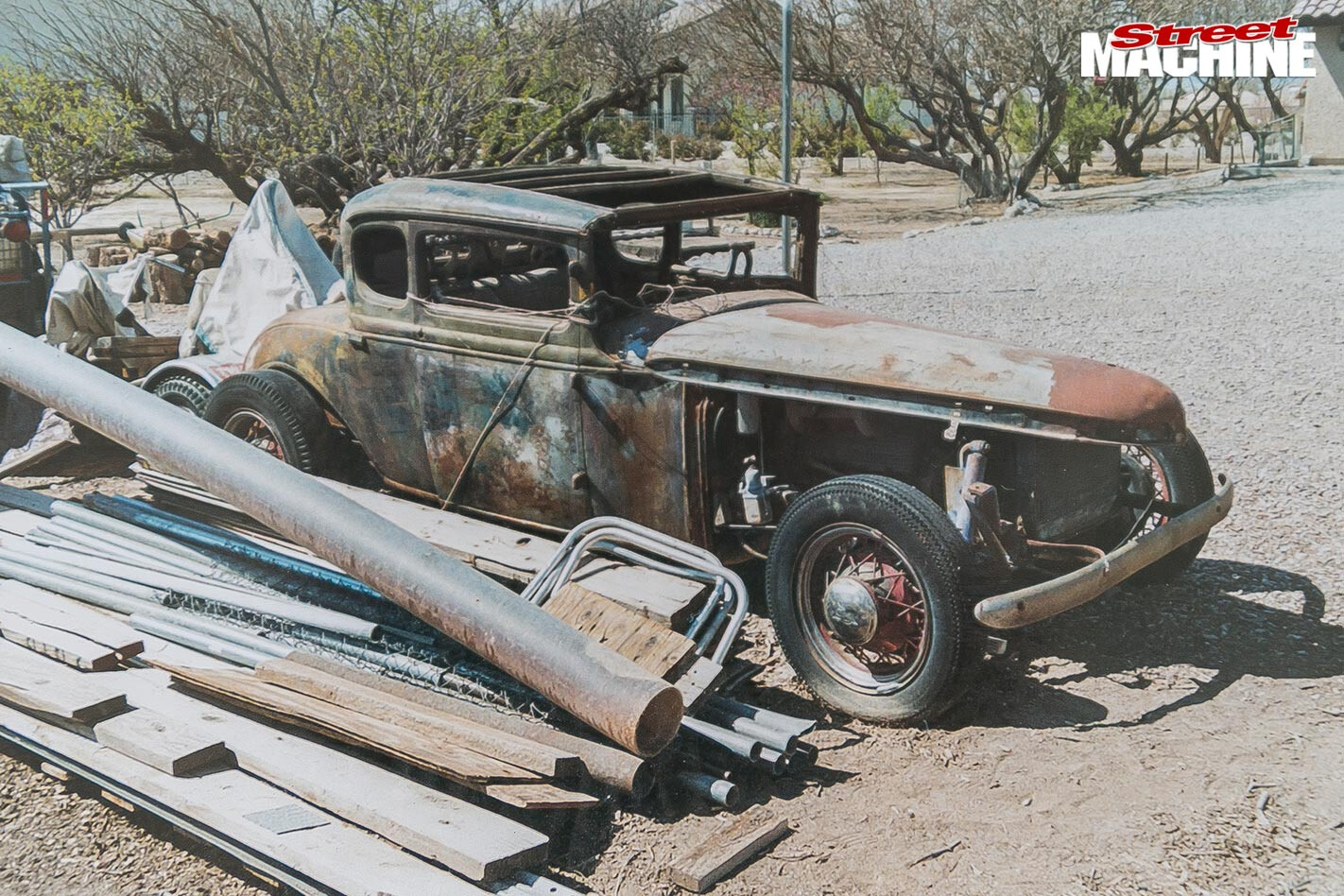 The long bonnet was placed on the car to protect the engine from the elements. The headlights went missing, and there is no explanation for the front bar. Perhaps it came from the same car as the bonnet top?
The long bonnet was placed on the car to protect the engine from the elements. The headlights went missing, and there is no explanation for the front bar. Perhaps it came from the same car as the bonnet top?
8. Con’s future wife Jackie, shot in the late 40s, most likely at Compton airport where Con worked on the BT-13.
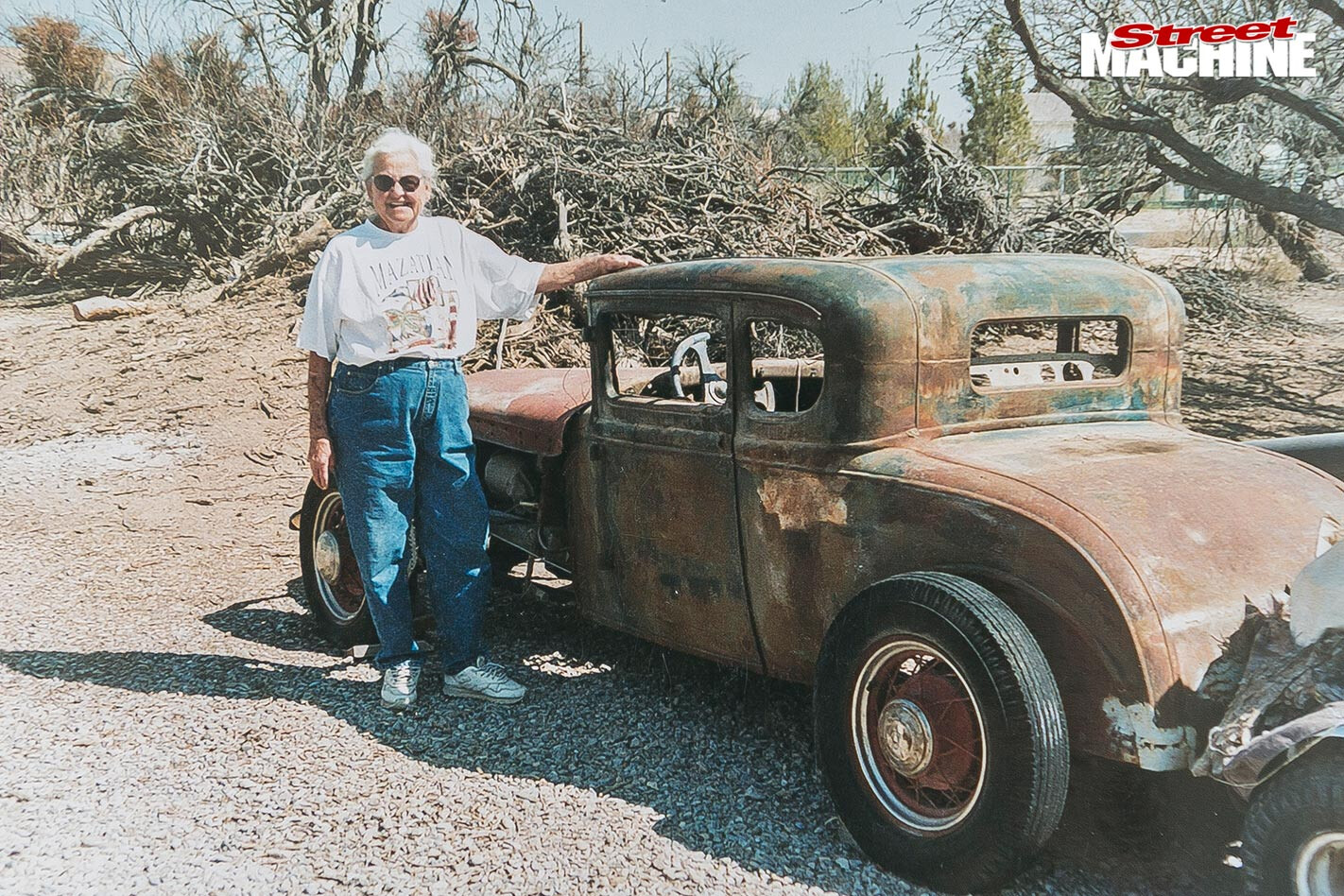 Jackie with the car when Jame and Mark Stormes took over custodianship.
Jackie with the car when Jame and Mark Stormes took over custodianship.
JAME STORMES
1931 MODEL A COUPE
Paint: DuPont Washington Blue
ENGINE
Type: 222ci Ford four-cylinder flathead
Inlet: Evans aluminium twin-port
Carbs: Twin Stromberg 97s
Head: 6.5:1 Thomas aluminium
Pistons: Stock, balanced
Rods: Stock, balanced
Valves: Stock
Cam: Stock, unknown re-grind
Camshaft: Stock, balanced
Radiator: Stock, shortened, electric fan
Exhaust: Stock manifold, Cherry Bomb glasspack muffler
Ignition: Mallory dual-point
TRANSMISSION
Gearbox: Stock
Diff: Stock
UNDERNEATH
Springs: Stock (f & r)
Shocks: Tube (f)
Steering: Stock
Brakes: Stock, modified mechanical linkages
ROLLING STOCK
Rims: 16in Kelsey-Hayes wires (f & r)
Tyres: 5.00-16 Harley Davidson (f), 6.00-16 Firestone Champion (r)
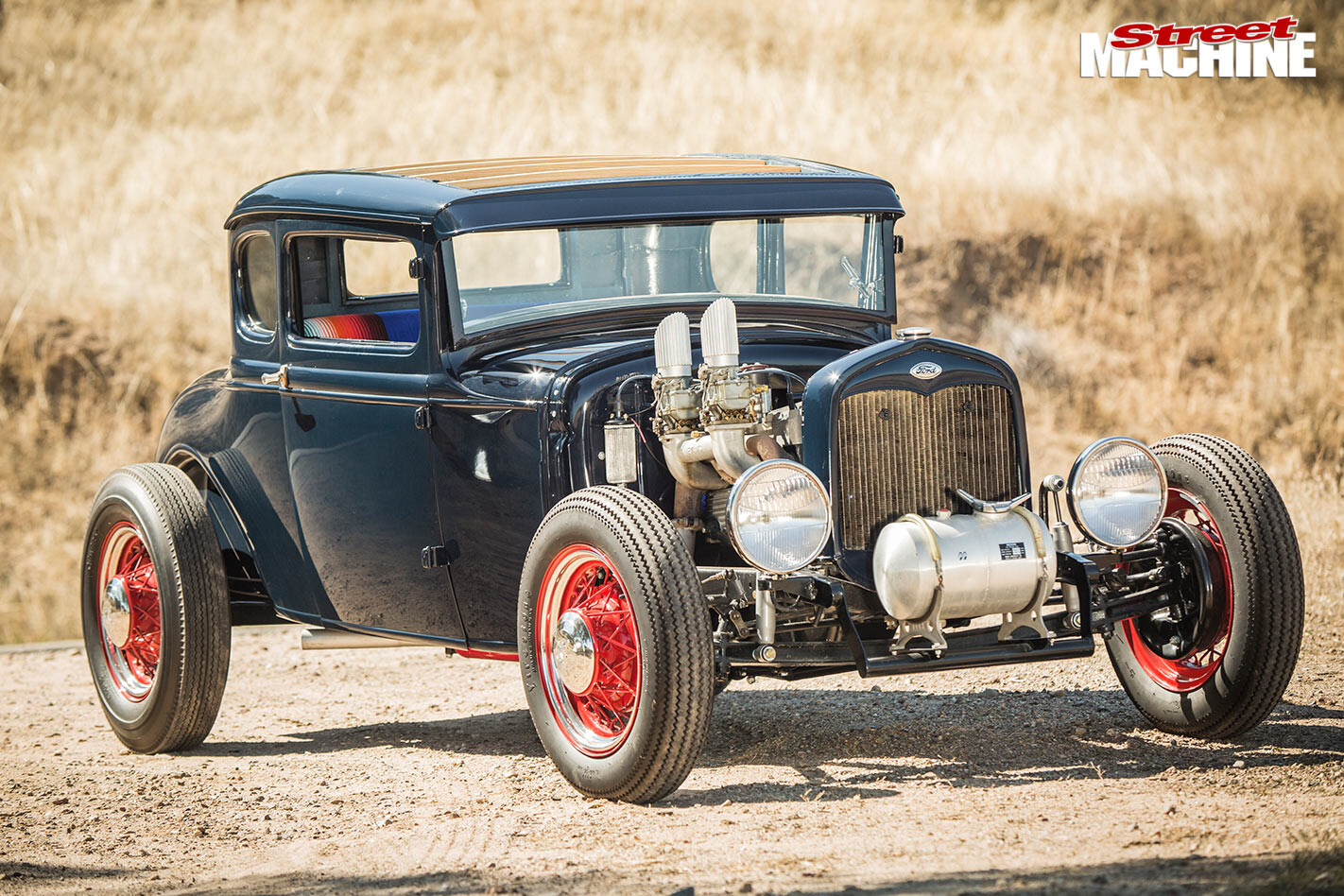
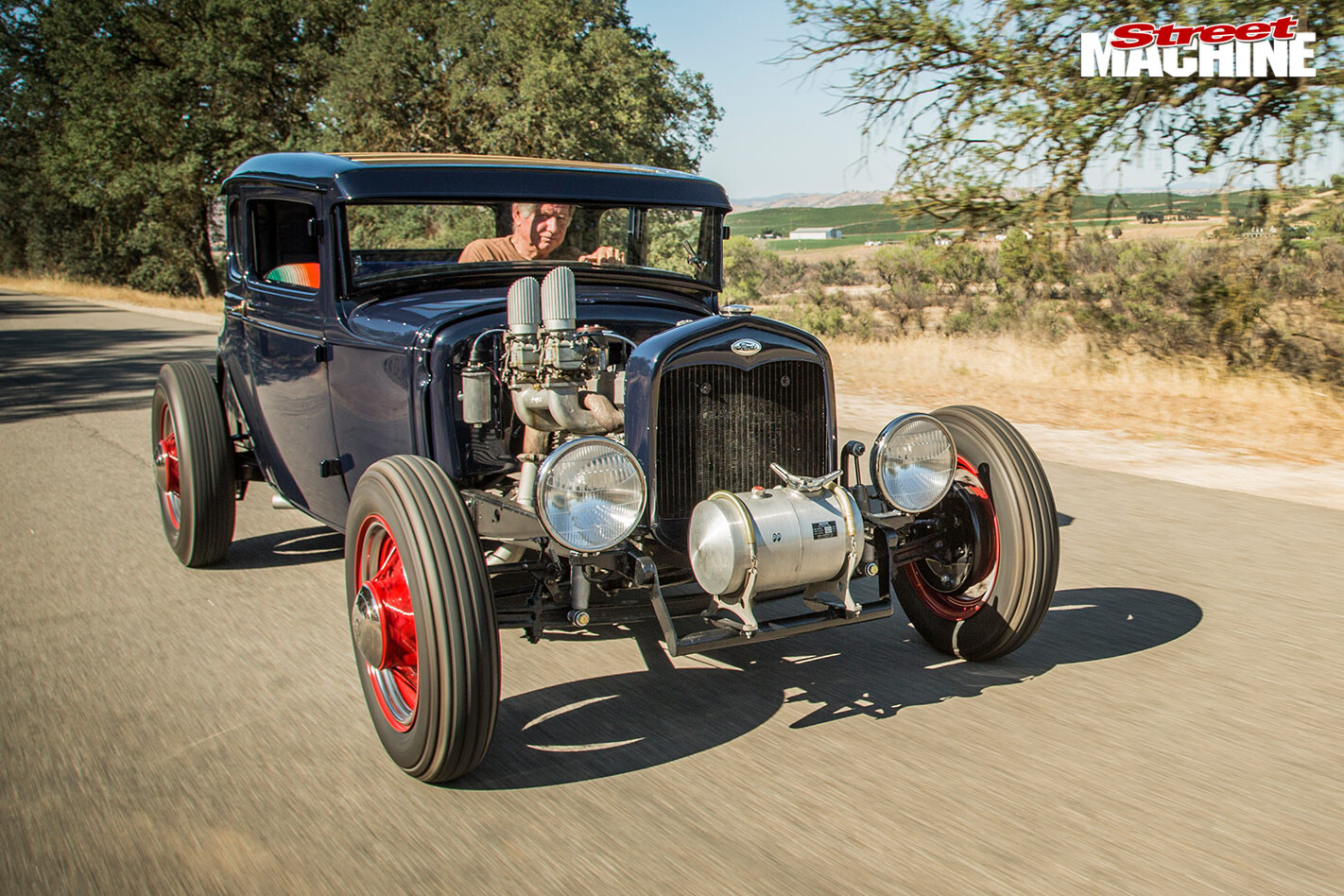
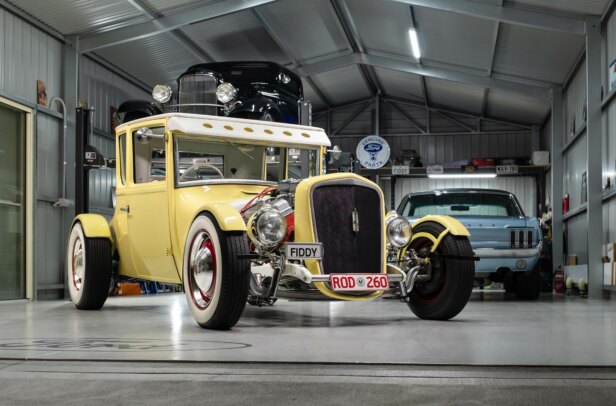
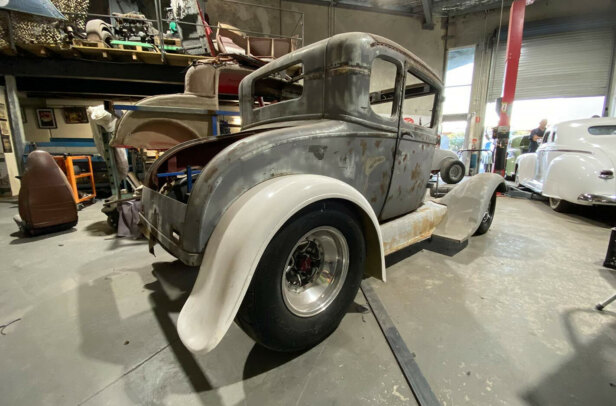
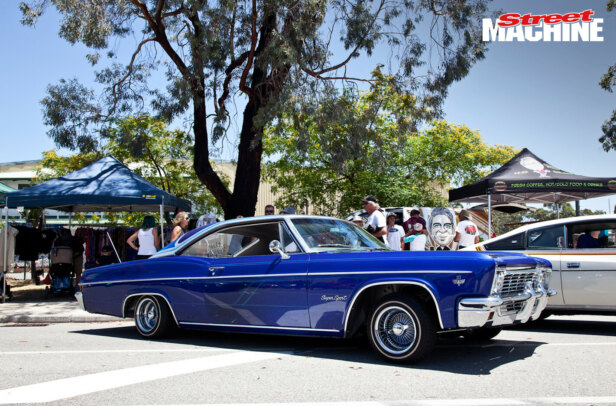
Comments